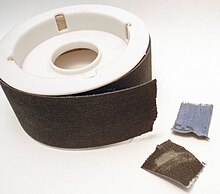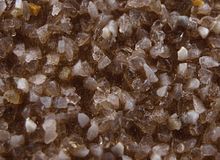Sandpaper
Sandpaper (general abrasive on a backing ), sometimes also referred to as glass, sand or emery paper , is an aid in surface treatment by grinding . Sandpaper is used to smooth rough surfaces or to break edges. It is also suitable for larger material removal. Sandpaper is used for wood, metal , lacquer and natural stone , among other things .
Abrasive cloth is used like sandpaper, but here the carrier material consists of fabric (formerly linen ). Abrasive cloth can be mechanically stressed many times more, thus achieving a longer service life. This also makes machine grinding possible, e.g. B. with a belt sander . When using circular sandpaper, hand-held sanders are used. The shape of the circular sandpaper has proven itself especially when sanding paints, metals and natural stone.
Grinding gives surfaces their final shape and fineness. As with sawing, rasping and filing, material is also removed when sanding .
Grit
Sandpaper or abrasive cloth are available in different grain sizes. The number of grains, which is usually stated on the back, is based on the unit of measurement mesh , the number of meshes of a net per inch (25.4 mm). The larger the number, the finer the grain. As a rough estimate, the following applies to the grain size: grain size in mm = 25.4 / grain.
| Grit | Grain information according to CAMI | Grain size in µm | use |
|---|---|---|---|
| rough | 6-30 | > 600 | Removal of glue and paint layers |
| medium | 36-80 | 538-201 | Rough pre-sanding of raw wooden surfaces |
| fine | 100-180 | 162-82 | Fine sanding of raw wooden surfaces |
| very fine | 220-1000 | 68-18 | Regrinding of watered, primed and painted surfaces |
The grain size and the associated activity depend on the respective application (e.g. material, machine, initial surface, desired surface) and the habits of the user. There are also strong regional differences in the processing steps.
The grain size is defined in the standards of the Federation of European Producers of Abrasives (FEPA) , for examples see Mesh (unit) and in DIN ISO 6344.
Abrasives
Flint ( flint ), garnet and emery were previously used as abrasives .
Today synthetic abrasives take their place, e.g. B. aluminum oxide , silicon carbide , chromium (III) oxide , zirconium (IV) oxide and other products of technical ceramics .
Sanding belt
A sanding belt is a ring-shaped bonded sandpaper of different length, width and grain size for clamping in a belt sander . There are suitable dimensions for every device. Please note the direction of travel, which is printed on the inside. If the sanding belt is used incorrectly, it will run backwards and the splice will tear after a short time.
scattering
Scattering or Coating refers to the number of the distributed on the base abrasive grains per unit area, that is, the spreading density .
With dense scattering , the backing is almost completely covered with abrasive grain, which leads to high material removal and a long service life of the abrasive. Dense scattering is mainly used in metalworking when there is no risk of the surface of the abrasive becoming clogged with adhering substances.
In the case of semi-open scattering , about 70-80% of the backing is covered with abrasive grain, so that space remains in the space between the abrasive grains in order to be able to remove abrasion from the processed surface. This variant is chosen when sanding hardwood, non-ferrous metals, plastics and paints.
With open scattering , about 50-70% of the backing is covered with abrasive grain, which leaves a larger chip space between the abrasive grains, so that grinding dust and adhering viscous materials can be picked up and ideally transported away without the abrasive clogging. This distribution should be selected for processing softwood and other long-chipping, sticky or soft materials.
With an open spread, less pressure has to be applied to achieve the same removal rate. On the other hand, the service life of the abrasive is reduced and the cut is a little less fine.
history
Isaac Fisher Jr. of Springfield (Vermont) received US Patents 8,246 and 8,247 on June 14, 1834 for the sandpaper manufacturing process he described .
In Germany, Carl Friedrich Schröder began in Münden in 1863 with the industrial production of coated abrasives.
literature
- Sam Allen: Surface treatment of wood - classic techniques and recipes . Publisher TH. Schäfer, ISBN 3-87870-586-7 .
- Michael Stibane: Green wood workshop for everyone who wants to furnish it . Amazon Create Space, ISBN 978-1-5028-1292-6 .
- Bernd Wittchen, Elmar Josten, Thomas Reiche: wood specialist. 4th edition. BG Teubner Verlag, Wiesbaden 2006, ISBN 3-519-35911-1 .



